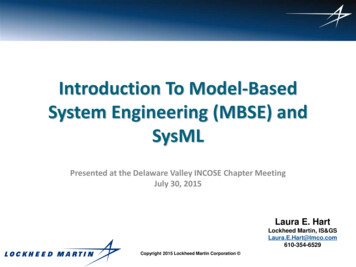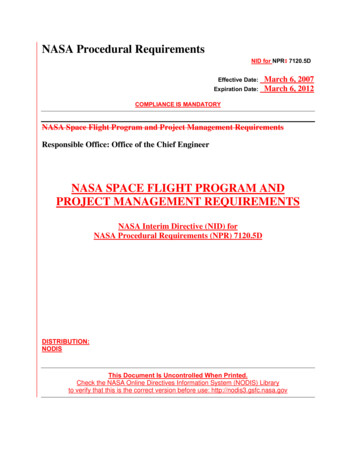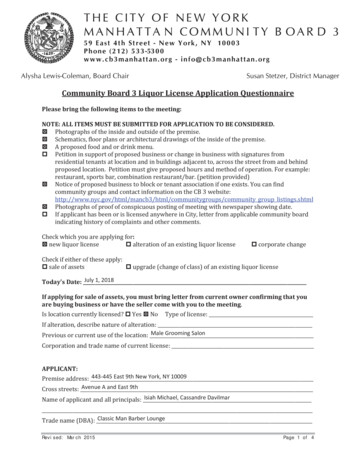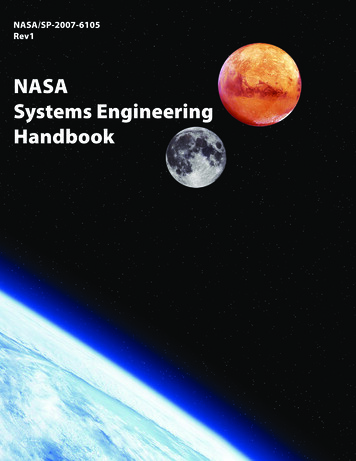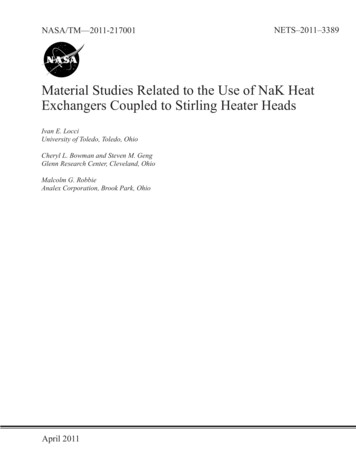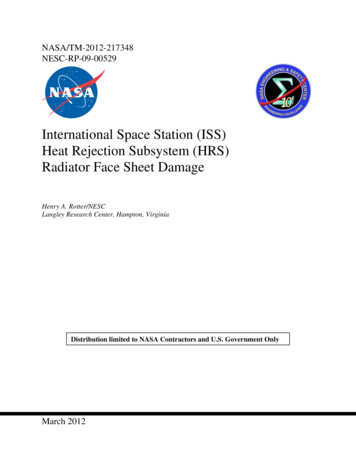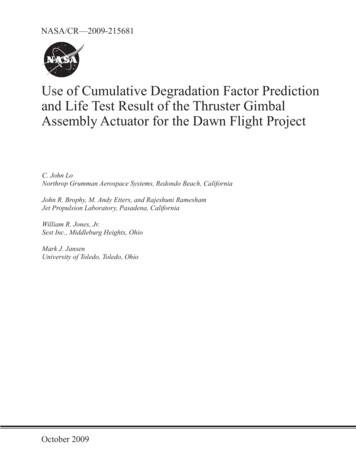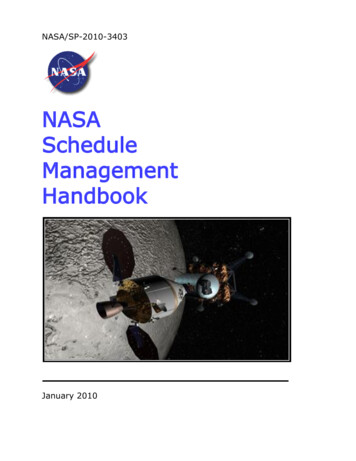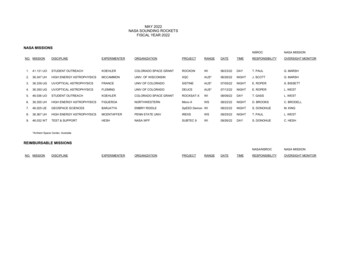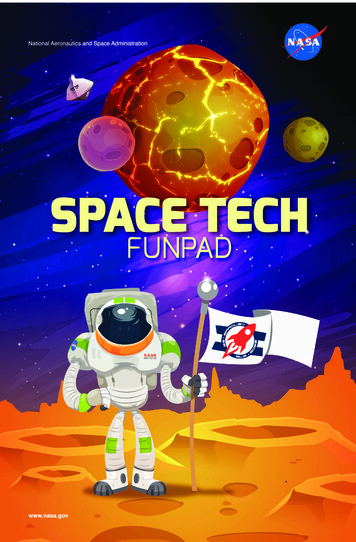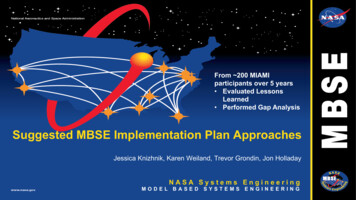
Transcription
From 200 MIAMIparticipants over 5 years Evaluated LessonsLearned Performed Gap AnalysisSuggested MBSE Implementation Plan ApproachesJessica Knizhnik, Karen Weiland, Trevor Grondin, Jon HolladayNASA Systems EngineeringMODEL BASEDSYSTEMSENGINEERING
Agenda MIAMI History and Lessons Learned MBSE Strategic Vision Updates Suggested Implementation Approach– Develop Project MBSE Capabilities– Project Deployment– Technology and Methodology Evolution– Change Process Approaches Mapped to MBSE Strategic VisionM A K I N GS Y S T E M SE N G I N E E R I N GE A S I E RF O RT H EW O R K F O R C E2
LegendNASA MBSE TimelineLoose PartneringKey ActivitiesNASA MBSE Pathfinder 2KickoffCoP Start50 Participants10 Centers DoD5 Use CasesTraining via GTMBSEPathfinderStrategy andUse CasesDefinedNIMA4 Yr Effort Request to EDsWhitepaper “Volunteers”BenchmarksMBSE PathfinderKickoff30 Participants9 Centers DoD4 Use CasesTraining via GTOCE CloudEnterpriseMD LicensingAPPEL MIAMI Kickofftraining 50 Participantsoffered9 CentersUMD11 P/p ApplicationsDsn. ThinkingCoP IntegratedTrng.zPathfinder 2Midterm ReviewTechnicalPathfinder 2Advisory Board Final ReviewformedROI 80%SoS IntegrationDiscipline IntegrationMBSE PathfinderReviewSix Months LaterW/F AdoptionUse Case Value20162017Departmentof DefenseGeorgiaInstitute ofTechnologyPartnershipsJoint PolarSatelliteSystemAsteroidRetrievalMissionNASA Safety andMission AssurancePrograms and ProjectsSLSStrategy GroupKick OffUniversity ofMarylandAcademy of Program, Project andEngineering LeadershipNASA OCIOEuropaNASA Engineeringand Safety CenterMIAMI MidtermPeer ReviewDesign Thinking2018Japanese AerospaceExploration AgencyNASAOffice ofthe ChiefEngineerEngineeringManagementAgency Program Direction Imp PlansManagementMBSE and MBx 200 MIAMI participants over 5 years Evaluated Lessons Learned Performed Gap AnalysisInfusionWhy?Can We?Tight PartnershipMainline WorkSpaceCommand NavNASA SpaceTechnologyMissionsMIAMI KnowledgeTargetedCapture MeetingDeploymentGaps & Lesson Learned Testing currentStrategy Deliveredresources with20 year visionExMC20192020USAF Space& MissileUSMCStrategic CommandCommandNASA TournamentLabX-Ray Imaging andSpectroscopyMissionExplorationResource Prospector Medical CapabilityMars AssentVehicleGatewayLvl1Urban Air MobilityChart content is not standalone, complements paper and verbal presentation.3
Top Lessons Learned Models should have a purpose. “Slow and steady wins the race.” Bold, committed leadership with authority and resources is needed. Modelers and innovators benefit from continual stakeholder engagement and re-engagement. New technology aligns with new ways of thinking. Amount of resources (time, money, and people) for MBSE innovation and implementation are still difficult toestimate. Streamline license access and infrastructure for modeling. Training is continually needed. Don’t reinvent the wheel. Use and re-use existing modeling infrastructure. Configuration Management (CM) and Data Management (DM) are obstacles for using MBSE for a larger ormore dispersed group. A model management plan can help.M A K I N GS Y S T E M SE N G I N E E R I N GE A S I E RF O RT H EW O R K F O R C E4
Suggested Future of MBSEStrategic VisionToolsProcessWorkforceWork to DateNear TermLonger TermEnd State- Workforce focused evaluations- Ease of MBSE adoption understood- MBSE CoP(s) established- Lessons learned captured- Partnerships established- Training sources identified- APPEL training established (Basic SE and MBSE)- Basic guidance for getting started and on commonproblems- Expand access to skilled modelers- Expand modeling skills- IT Support- Improve speed and quality of SE capability- Improve NASA mission response (do more)- Define implementation leadership authority- MBSE and SE become "synonymous"- Computer has adopted science of SE- Human is fully focused on art of SE- Digital Twins- Near instantaneous design cycles- Computer consults human for guidance- Aligns with NPR7120 & 7123, other NPRs,and NASA endorsed standards- Rigorous technical peer review- Workforce adoption ease validated- Focused MBSE/SE ROI validated- Over a dozen projects supported- External alignment interviews- Standards community participant- Partnerships with DoD, NIST, etc.- Model version control- Formalize library of existing products toleverage- Templates for model decomposition- Templates for model integration- Model Management Guidance- Model Management Handbook- MBSE Architecture Framework Handbook- Agreement on contract/DRD approach- MBE Acquisition Framework Handbook- Incorporate DE, MA, and/or PM linkages- Tech baseline is adjusted real-time- M&S reduces complexity overhead- Formulation and implementation bridged- More thorough trade space evaluation- History and M&S validate models and givedecisions improved credibility- Validated models become data rich- Concept models become more accurate- Seamless data flow- Standards solidify from best practices- Seamless Data Availability (AI and MLenabled)- SE Integrated with PM (Schedule and Cost)- SE Integrated with Eng. (Digital Twins)- MA easily monitors Eng w/o impactingschedule- Enterprise Cloud established- Enterprise Magic Draw with SysML andparametric analysis plug-ins established- Numerous MBSE tools evaluated- Installation FAQ guide- Tool version control- Expand enterprise cloud to serve larger- Data availability integration offers major impact- Tools become a transparent agent- Human computer I/F seamlessengineering workforce- Enterprise Cloud S/W tools expansion- Increase Magic Draw, plug-in, and othertool license access- Incorporate SE data analytics around margins,test data, bounding conditions- Incorporate richer visualization graphics forinternal and stakeholder use- Data is authoritative source of truth- SE tooling becomes highly evolved- Human computer I/F more seamless5
Agency-wide MBSE CapabilityImplement Project Adoption today while developing Enterprise Level Adoption for the future.Project-level (Phase 1)Enterprise-level (Phase 2)Workforce MBSE-fluent users Use on multi-center, multi-level, virtual, government and contractor teams Agency, Center and Mission Directorate MBSE Leadership and CoPsProcesses Project defines the model architectureand model management approach Agency-wide best practicesTools andInfrastructure Seamless data approach for systems engineering across the project lifecycle Seamless data approach for interactions with other disciplines Host server and software for MBSE collaborative environment Dedicated IT support personnel Agency-wide common sets of tools for MBSE and other disciplinesStrategy andApproach Tested and validated for project-levelimplementation (informs Enterprise)M A K I N GS Y S T E M SE N G I N E E R I N GE A S I E RF O RT H E Agency-wide common modelarchitectures and managementapproaches, based on NASA lines ofbusiness Agency-wide standards Tested and validated for NASAenterprise-level implementationW O R K F O R C E6
Change Process: Support the Workforce Help grassroots help themselves– Remove infrastructure, policy, and procedure roadblocks– Equal cross-center representation and collaboration is needed to keep MBSE valuable across theagency Build connections for the workforce– Within and across centers– Between SEs and MBSE practitioners– Between MBSE practitioners– Between workforce and managementWhen in doubt , do what’s best for the workforce.M A K I N GS Y S T E M SE N G I N E E R I N GE A S I E RF O RT H EW O R K F O R C E7
Change Process: Small Team of Leaders One senior,visible, respected leader should– Reside within the funding organization– Have the decision-makingauthority and resources Other leaders can be matrixed; should represent diverse NASA communities All leaders need to be boldand committed to MBSE implementation– Ideally most should dedicate a significant portion of their time ( 50%)– Positions need to be recognized as serious jobs Today, tomorrow, and future leadership functions keep the efforts focused on realproblems, aligned across timeframes, and connected with real usersRemove roadblocks for the workforceM A K I N GS Y S T E M SE N G I N E E R I N GE A S I E RF O RT H EW O R K F O R C E8
Capability: IT Infrastructure Converge on MBSE collaborative environment and associatedserver – partner with OCIO– Meet users and sponsors needs – Easy access, Data protection, Collaborationwith non-NASA partners, Capacity for majority of workforce to use Update to current tools – Including: Teamwork Cloud, Syndeia, OpenMBEE,MapleSoft, Cameo Collaborator, and many others Easy and clear NAMS process – For licenses, project uploads and projectaccess Policies do not yet account for some needs – Most needs are technicallypossible– IT support Readily available to assist projects and users with software implementation Need transition to actual production implementation pilot testing Modelers regularly advise on software and server needs– Capture and use lessons from OCE Cloud, XRISM Collaborative Environment,ISS, GRC, and others to fine tune next steps Seamless data flow – In the near term, continue using and developingscripts and plug-ins to access multiple, independent data centers, influence growCOTSM A K I N GS Y S T E M SE N G I N E E R I N GE A S I E RF O RT H EHedberg (NIST), et al., “Towards a Lifecycle InformationFramework and Technology in Manufacturing,” Journal ofComputing and Information Science in Engineering, 2016W O R K F O R C E9
Capability: Workforce Skills – Make and Buy Make– Need to make training available to meet workforce and project demand Theory training – like APPEL’s current training Practice training – like Georgia Tech’s SysML 101/201– Communities of Practice (CoPs) Center and Mission Directorate groups should coordinate with and feed into the agency CoP Center and Mission Directorate groups can focus on their specific use cases while the agency CoP looks at common needs Capture and Consolidate best practices (for example: architecture frameworks, configuration and data mgt.) Buy – Advice, On the Job Training , and direct modeling support have driven MBSE successIn both cases, work with: OCHCO tounderstand andrecruit future staffing. OCKO to implementtraining.– NASA needs more bench depth of people (especially highly skilled ones) to build models Provides surge capability Provides OJT learning opportunities for in-house workforce– Desired Attributes Early career and later career members Modeling and scripting skills– Challenge is finding an Agency funding source, money is only available in Projects and Mission Directorates. Programs/projects should fund modelers (could be a common contract or a temporary contract). Agency should decide the level of enterprise integration and sharing across programs/projects and Mission Directorates.M A K I N GS Y S T E M SE N G I N E E R I N GE A S I E RF O RT H EW O R K F O R C E10
Targeted Projects: Attributes Potential for Success with MBSE– Significant, well-scoped problem– Ability to meet clear success criteria using NASAMBSE capability– Not significantly bought in to another method tosolve their problem– Relationships with other groups– Communicative point(s) of contact– Resources to afford the capability Willingness to Communicate Positively– Lead Systems Engineer interested in MBSE– Credibility with other engineers– Obvious next projectM A K I N GS Y S T E M SE N G I N E E R I N GE A S I E RF O RT H EW O R K F O R C E11
Technology and Methodology Evolution Project Minimum Need – pursue immediately– Seamless data flow – what is it and where is it needed (PM, MA,Eng ?) for the longer-term investigate options with OCIO forenterprise level seamless data flow (inter-model and inter-IT).WYFIWYG!(What You Foresee Is What You Get!)– Enterprise solution – What is the enterprise? What are the options?– Integration between SysML tools and between organizations– Integration with other disciplines – SMA, cost, other engineeringdisciplines, acquisition, etc.– Best practices evolve into standards? Beyond SysML – for both current implementation andfuture–––––SysML 2.0Data centrism – right now we are model centricOther tools – SysML based or notVisualizationEnhanced systems analysis capabilitiesM A K I N GS Y S T E M SE N G I N E E R I N GE A S I E RTechnology Advancement Enterprise level – implement in 3 to 5 yearsFutureCapabilitiesCurrentCapabilitiesTimeF O RT H EW O R K F O R C E12
Change Process: Small Steps Acknowledge that we don’t know enough to moveahead confidently Useiterative small step principles– Talk to current users to understand the why’s and how’s ofwhat they’re using – both inside and outside of NASA– Get a little bit and try it out– Assess and iterate or pivot We are not alone – Leverage and collaboratewith interested partners like OCE, OSMA, OCIO, JAXA,ESA, DoD, NIST, and potentially others like Boeing, BallAerospace, and Blue OriginM A K I N GS Y S T E M SE N G I N E E R I N GE A S I E RF O RT H EW O R K F O R C E13
Suggested Implementation ApproachChange Process: Dedicated Institutional Leadership Oversees Iterative, Incremental GrowthMBSE infuses into more projects viacommunication of positive resultsAgency-WideProject SolutionDevelop Project MBSECapabilities: IT Infrastructure Workforce SkillsSatisfy Systems EngineersProjectDeploymentEngineers informevolutionAgency-WideEnterprise andBeyond SolutionM A K I N GS Y S T E M STechnology and Methodology EvolutionE N G I N E E R I N GE A S I E RF O RT H EW O R K F O R C E14
New technology aligns with new ways of thinking. Amount of resources (time, money, and people) for MBSE innovation and implementation are still difficult to estimate. Streamline license access and infrastructure for modeling. Training is continually needed. Don’t reinvent th
